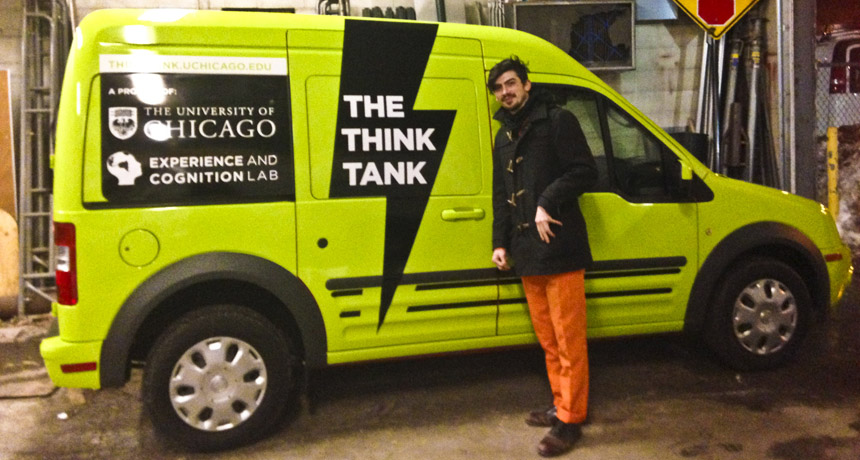Neuroscience on wheels comes to Chicago
The Think Tank is an outreach initiative that brings the brain wherever there’s a parking space

Tyler Alterman poses with the Think Tank, a van that brings neuroscience education to students and families.
Tyler Alterman
CHICAGO —Tyler Alterman was still an undergraduate neuroscience student at the City University of New York in New York City when his mother told him about an art exhibit. It was called “Trailer Park.” But instead of a trailer in a park, the exhibit was a park in a trailer. Viewers stepped into the trailer and found themselves surrounded by trees, grass and birdsong. “I thought, if it worked for nature,” says Alterman, “why not for neuroscience?”
That’s the idea behind the Think Tank, a new kind of neuroscience outreach. The Tank itself is a bright green van with a plastic brain on top. Alterman and cognitive neuroscientist Dan Casasanto from the University of Chicago are using the van to bring neuroscience anywhere with a parking spot. Step inside the vehicle and into a world of neuroscience.
The Tank will drive to public festivals all around Chicago, but it’s far more than a big green van. At each stop, University of Chicago neuroscience undergraduates who call themselves the Brainiacs, will deliver sidewalk talks and perform science demonstrations. The student group also offers a five-week curriculum for schools, with lessons designed to complement the Next Generation Science Standards. Finally, a fellowship program offers high school students the chance to learn about research for themselves. The Think Tank will help to place teens in laboratories at the University of Chicago, where they can experience neuroscience first-hand.
The project is only in its second year. While the five-week school visits introduce deep concepts, including bioethics and brain disease, the Street Science is mostly focused on “wow” moments. Once kids get inside the Think Tank, they will be able to try on Emotiv electroencephalography headsets, which translate the electrical signals produced by the brain into dots on a computer screen. The EEG cap, Alterman says, “is one of the few things that makes people go ‘wow!’ It shows people how the mind relates to the body.”
While visitors may be inspired, it’s hard to understand how EEG helmets work, and Alterman admits “I don’t think it actually teaches people that much.” But he believes that it is just as important to show what scientists don’t know as it is to show what they do know. Alterman is particularly focused on reaching out to groups currently underrepresented in neuroscience. “The crazy vehicle is a great backdrop,” he says, “for engaging kids and their families who might not normally think about the brain.”
The Think Tank is still fully outfitting its van, but is still doing live demonstrations and school visits. Anyone can book a van stop through their website.
Power Words
bioethics A branch of philosophy that looks at matters of right and wrong related to advances in biology and medicine. Bioethics can discuss many issues, including cloning, organ transplants and genetically modified fruit.
electroencephalography Otherwise known as EEG, this is a technique that records the tiny electrical impulses in your scalp. The electrical changes correspond to the activity of neurons in the brain.
neuron or nerve cell Any of the impulse-conducting cells that make up the brain, spinal column and nervous system. These specialized cells transmit information to other neurons in the form of electrical signals.
neuroscience Science that deals with the structure or function of the brain and other parts of the nervous system. Researchers in this field are known as neuroscientists.